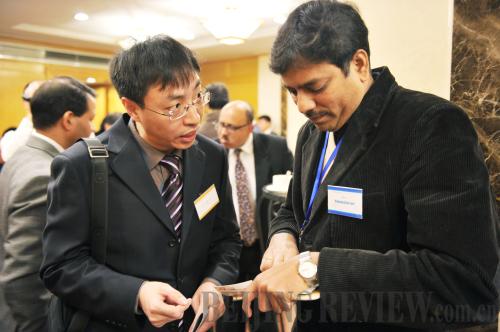|
 |
|
INDUSTRY CONNECTIONS: A Chinese media professional exchanges ideas with an Indian colleague at the Second China-India Media Forum in Beijing on February 1 (WEI YAO) |
Statistics compiled in 2013 showed that there are only four Indian media professionals stationed in China; meanwhile, about a mere dozen Chinese reporters were working full-time in India. This shortage has resulted in a heavy reliance on Western media reports. Chand noted that, like the Chinese media, "The Indian media narrative is often inspired by Western narratives that project India and China as rivals."
"The status quo obviously doesn't live up to the importance of bilateral relations. To present a true China and a true India, it is urgent for media from both countries to devote more reporters to the cause," said Tang Shubiao, Editor in Chief of China Today.
Converging interests
As China-India economic ties deepen rapidly, media from both sides can play a much larger role in promoting the convergence of their interests as well as cooperation.
Currently, China is the largest trading partner of India, with total trade volume in 2014 exceeding $70 billion, while the number was merely $1 billion in 2001. The two countries plan to raise bilateral trade beyond $100 billion in 2015.
China and India—the global manufacturing giant and major service provider, respectively—may complement each other well with their different economic strengths. However, reports on the two countries' economic development and cooperation are still relatively few in number.
Li Yang, a senior journalist with China News Service, said there is great potential to be tapped for business news reporting. Taking the renowned Indian industrial giant Tata Group's China strategy as an example, Li said that increasing reports on each other's business strategies could certainly increase bilateral cooperation.
Atul Aneja from The Hindu said China's 21st Century Maritime Silk Road initiative, currently underreported in the Indian media, could also bring about big opportunities for India's business circle.
Vaidyanathan Iyer, Deputy Editor of Indian Express, said the media can promote the settlement of some economic and trade problems between the two countries.
Liu of CCTV suggested that the Chinese and Indian media be platforms for explaining the rules and regulations in trade, investment, finance, and tax of each other's country. "For example, China has established three free trade zones. What does that mean to foreign investors? What preferential policies can they get in these zones? We can do a lot of coverage on that," Liu said.
Making progress
The launch of the China-India Media Forum was also one of the agreements reached during Chinese Premier Li Keqiang's visit to India in 2013, with the first forum held in New Delhi in September that same year.
Zhou Mingwei, President of China International Publishing Group, a Beijing-based media conglomerate targeting international audiences and the organizer of the event, said as the forum has evolved into a regular platform for exchanges, mutual trust between the media from the two countries is increasing gradually.
Zhou said that the first forum was predominated by arguments and even accusations, whereas the most recent forum focused on settling existing problems.
When addressing the opening ceremony of the forum, Indian Foreign Minister Sushma Swaraj appealed to the media from both sides to converge on common regional and global interests, develop new areas of cooperation and expand strategic communication with the aim of initiating a new century of mutual learning between the two countries and realizing the dream of an "Asian century."
In the statement issued at the end of the second forum, delegates proposed a China-India Media Fund financed by the two countries' leading media organizations to promote journalistic exchanges and hold seminars or conferences. Participants also agreed to increase the numbers of journalists stationed in both countries, while vowing to reduce dependence on news sources from Western countries.
"Initial progress has been made in promoting personnel exchanges and information sharing between Chinese and Indian media organizations," said Zhou at the closing ceremony of the forum. "At the same time, we should be keenly aware that our mutual understanding still falls far short of demand at a time when bilateral ties are thriving. It is imperative that we devote more efforts and greater wisdom to expanding China-India media cooperation."
Email us at: yulintao@bjreview.com | 